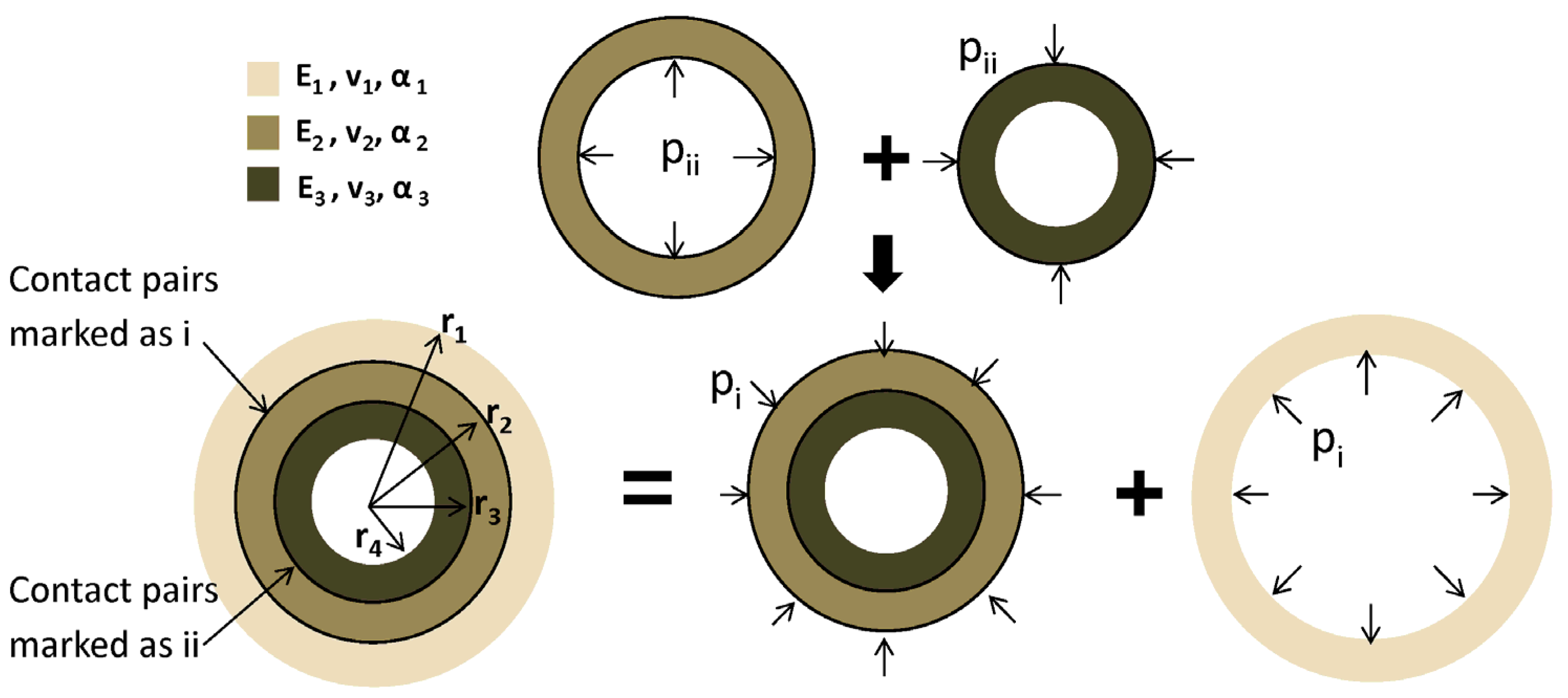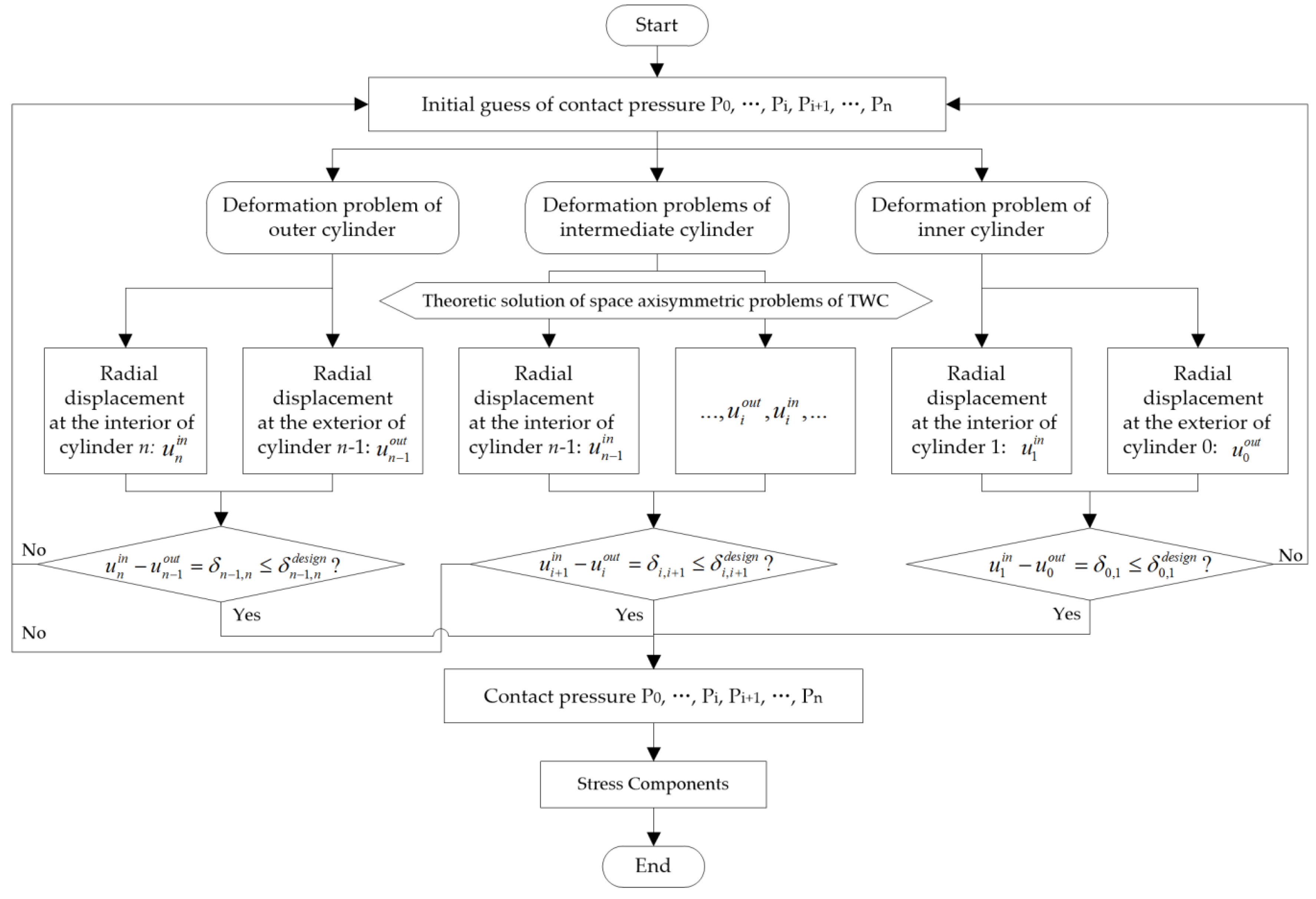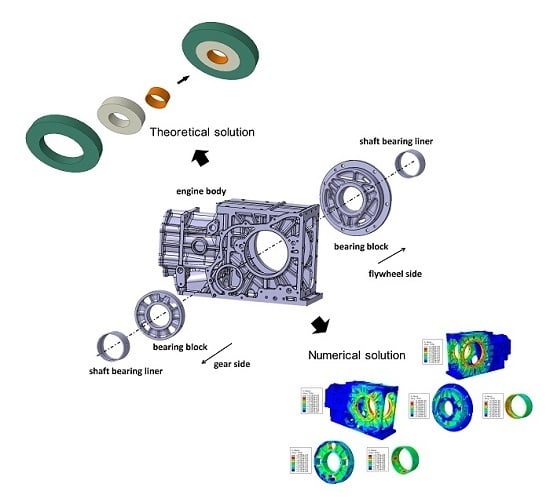2.1. Interference Quantity Design of MLTWC
Certain interference has to be assured to prevent interference surface skid in mechanical transmission device. Meanwhile, the interference cannot be too big to avoid that the component stress falls into plastic zone and lose efficacy. Therefore, the size and tolerance of components must be designed in a reasonable range to realize a befitting interference quantity and thus the effective torque transmission.
The designed transmission torque can be determined according to design requirements, which is the maximum torque that can be transmitted by the interference surfaces. The actual maximum torque needs to be larger than the designed transmission torque by a rational interference quantity, i.e., . There exists simple quantitative relationships between contact pressure and the actual maximum torque , i.e., , here, represents static friction coefficient, contact area and radius of the contact face, respectively. Thus, the relationship between the interference and the maximum transmission torque can be found if the quantitative description of and P is determined. The lower limit of the interference quantity can be determined by the designed torque.
Excessive interference leads to such high contact pressure that there will be stress concentration inside the components. If the stress exceeds the plastic yield stress,
i.e.,
, the MLTWC loses efficacy due to unrecoverable local deformation. Hence, there exists an upper limit
resulting from the limit of the maximum stress.
Figure 1 shows the calculation principle for interference.
2.2. Relationships between Interference and Tolerance
Suppose the axial diameter is
, and the bore diameter is
, where
D is diameter, and superscript
represent ecart superieur, and subscript
represent ecart inferieur. There exists relationship between maximum interference
and the tolerance for a certain pair of interference fit, as shown in Equation (1):
The minimum interference
also has relationship with the tolerance, as in Equation (2):
The deviation value of axis and bore in the interference pair can be totally determined with the given tolerance zone, i.e., the value of and (.
2.4. Analytical Solution of Bi-layer Thick-walled Cylinders
The left subgraph in
Figure 2 describes the interference problem of bi-layer thick-walled cylinders. Within small elastic deformation, such problems satisfy superposition principle, and can be decomposed into two independent space axisymmetric problems of thick-walled cylinder, as shown in right side of the equal sign in
Figure 2. The overall calculation process of interference algorithm for BTC is shown in the flow diagram,
Figure 3.
The thick-walled cylinder with inner and outer radius of
r2,out and
r1 respectively as shown in
Figure 2 is under uniform internal pressure
Pi, and there is no external pressure. The Young modulus of this cylinder is
E1; its Poisson’s ratio is
v1, and the thermal linear expansion coefficient is
α1. According to the theoretic solution of space axisymmetric problems of thick-walled cylinder, the radial displacement at the inner surface of this cylinder can be expressed as:
where the subscript
r in
represents radial direction, and the subscript out indicates outside of the contact surface.
The thick-walled cylinder with inner and outer radius of
r3 and
r2,in respectively as shown in
Figure 2 is under uniform external pressure
Pi, and there is no internal pressure. The Young modulus of this cylinder is
E2; its Poisson's ratio is
v2, and the thermal linear expansion coefficient is
α2. According to the theoretic solution of space axisymmetric problems of thick-walled cylinder, the radial displacement at the outer surface of this cylinder can be expressed as:
where the subscript
r in
represents radial direction, and the subscript
in indicates inside of the contact surface.
Assembling two concentric thick-walled cylinders together,
r2,out is slightly smaller than
r2,in, and the difference between them is the interference
δi as shown in Equation (6), which determines the displacement coordination between the inner and outer cylinders on the contact surface.
The displacement along the radial direction is set to be positive, otherwise it is negative.
Derived from the displacement coordination in Equation (6), the contact pressure
Pi can be obtained as shown in Equation (7):
Approximately regarding
r2,out is equal to
r2,in, and denoting both of them as
r2, the simplified pressure is expressed in Equation (8).
Few coaxial components in contact can be found in actual structure as flawless thick-walled cylinders as in theoretical assumptions. Various local reinforced or lightened structures are added. Therefore, the actual material stiffness needs to be discounted according to the volume fraction of the material, which is defined as the percentage of the actual component volume to the volume of an ideal thick-walled cylinder taking component outer contour as the boundary. Such volume fraction is regarded as the stiffness discount factor
, so that the contact pressure between the bi-layer thick-walled cylinders is:
Equations (8) and (9) indicate that the contact pressure is in direct proportion to the interference, the proportionality coefficient of which depends on the geometrical characteristic and material property of the contact pair. Material with larger Young modulus has larger proportionality coefficient, resulting in higher contact pressure.
Given the contact pressure of the bi-layer cylinders , the stress of the inner and outer cylinder are shown in Equations (10) and (11), respectively, from the theoretic solution of space axisymmetric problems of thick-walled cylinder.
Stress of the inner cylinder,
Stress of the outer cylinder,
2.5. Analytical Solution of Tri-layer Thick-walled Cylinders
Three nested thick-walled cylinders go with one another for interference. The calculation flow for contact pressure and interference of tri-layer thick-walled cylinders with different assembly sequence is shown in
Figure 4.
Figure 5 shows the superposition principle of tri-layer thick-walled cylinders installed from inside to outside; while
Figure 6 indicates the installation from outside to inside.
Figure 7 presents the installation when the contact pairs are formed simultaneously. From
Figure 5,
Figure 6 and
Figure 7, different colors represent different coaxial thick-walled cylinders with the material parameters of
E1,
v1,
α1;
E2,
v2,
α2; and
E3,
v3,
α3, respectively, wherein
E is the Young's modulus,
v the Poisson ratio, and α the thermal linear expansion coefficient. The outer cylinder in light gray and the medial cylinder in gray form a contact pair at radius
r2, denoted as contact pair
i, and the variable relevant to this pair are represented with the subscript
i. In the same manner, the contact pair composed of the medial cylinder in gray and the inner cylinder in dark gray radius
r3 is represent by
ii.
2.5.1. Installation from Inside to Outside
The installation is split into two steps: the inner contact pair
ii goes first, and then the outer contact pair
i is assembled. To calculate contact pressure, the two pairs are analyzed separately, and then the results of them are superposed on the basis of superposition principle, as shown in
Figure 5.
The interference of the inner contact pair
δii can be solved by Equation (3). Using the simplified Formula (8) to calculate the contact pressure between two thick-walled cylinders, the contact pressure of the inner pair
ii is derived as:
According to the solution of the thick-walled cylinder axisymmetric problem, the contact pair
ii will lead to a radial displacement at the exterior of the medial cylinder, as shown in Equation (13).
Such radial displacement results in an increase of the interference of the outer contact pair
i. Denoting this increase as
, the value of which is equal to
.
indicates the monodirectional effect from contact pair
ii to
i. Based on the Formula (3), the interference
of contact pair
i should be expressed as:
Applying the simplified computational formula (8) to calculate the contact pressure
Pi of the contact pair
i, Equation (15) can be derived:
Such calculation is in accordance with the component installation from inside to outside. The calculated contact pressure of the inner contact pair ii is not the final result. The outer contact pair i increases the material stiffness of the exterior of the inner contact pair, and thus increases the contact pressure of the inner contact pair. The calculated contact pressure of the inner pair is smaller than the actual value. Besides, the calculation of the contact pressure of the outer pair also does not consider the impact of the innermost material stiffness, as a result, the calculated value is as well smaller than the actual value.
2.5.2. Installation from Outside to Inside
This time, the outer contact pair
i is assembled firstly, and then the inner contact pair
i is fit. Similar with the calculation in
Section 2.5.1, the superposition principle of the contact pressure of the two contact pairs is shown in
Figure 6.
The interference of the outer contact pair
δi can be solved by Equation (3). Using Formula (8) to calculate the contact pressure between two thick-walled cylinders, the contact pressure of the outer pair
i is derived as:
The radial displacement at the interior of the medial cylinder resulting from the outer contact pair
i is:
This displacement leads to an interference increase of inner contact pair
ii, denoted as
with the value of
.
indicates the monodirectional effect from contact pair i to
ii, and the interference
of contact pair
ii is:
The contact pressure
Pii of the contact pair
ii is calculated by Formula (8):
The calculation above is in accordance with the component installation from outside to inside. The calculated contact pressure of the outer contact pair i is smaller than the actual value, since the existence of the inner contact pair enlarges the interior material stiffness of the outer contact pair, and thus enlarges the contact pressure of the outer pair. The calculation of the contact pressure of the inner pair also does not take the impact of the outermost material stiffness into account, and the calculated value is thus smaller than the actual value too.
2.5.3. Holistic Coupling Analysis
Within a small elastic deformation range, the interference problems of tri-layer thick-walled cylinders satisfy the principle of superposition, which can be divided into three separate thick-walled cylinders problems of space axially symmetry. The calculated results of these separate parts are then superposed based on the principle of superposition, as shown in
Figure 7.
According to the theoretical solution of thick-walled cylinder axisymmetric problem, the radial displacement at the interior surface of the outermost cylinder , the radial displacement at the exterior surface of the medial cylinder , the radial displacement at the interior surface of the medial cylinder , and the radial displacement at the exterior surface of the inner cylinder can be derived, as shown in Equations (20)–(23).
The interference of the inner and outer contact pair of the nested thick-walled cylinders determines the displacement coordination of the corresponding cylinders on the contact surface.
Substituting the radial displacement in Equations (20)–(23) into displacement coordination in Equations (24) and (25), the contact pressure can be derived.
2.5.4. Stress Analysis
Given the contact pressure and of the tri-layer cylinders, the stress of the inner, medium and outer cylinder are shown in Equations (26)–(28), respectively, from the theoretic solution of space axisymmetric problems of thick-walled cylinder.
Stress of the inner cylinder,
Stress of the medium cylinder,
Stress of the outer cylinder,
2.6. General Analytical Solution of Multiple Contact Pairs for the MLTWC
Without loss of generality, the interference fit of a MLTWC system with
n thick-walled cylinders is studied, as shown in
Figure 8. A holistic coupling method is developed to analyze the interference of MLTWC. The calculation flow diagram for the interference algorithm without consideration of assembly sequence is illustrated in
Figure 9.
The interference fit between the
ith layer and (
i + 1)
th layer of the MLTWC is shown in
Figure 8, which is composed of the outer surface of the
ith thick-wall cylinder and the inner surface of the (
i + 1)
th cylinder. The radial displacement
u of these two surface needs to satisfy the displacement coordination described in Equation (29), so that there is no gap or penetration between these two surfaces.
where the superscript represents the inner and outer surface, respectively.
Under the hypothesis of small elastic deformation, the interference fit of n MLTWC satisfies superposition principle, which can be equivalent to
n axisymmetric thick-wall cylinders with uniformly distributed interior and exterior pressure. According to the elastic theory solution, the radial displacement of the outer surface of the
ith cylinder is shown in Equation (30).
Since
is small compared to
, Equation (30) can be simplified as in Equation (31).
Put Equations (31) and (32) into Equation (29), then
Expand it and group terms, Equation (34) can be derived.
It can be seen from Equation (34) that
,
, and
all have their own contributions to
, which is determined by the parameters of material and geometrical characteristics. Represent the coefficients of
,
, and
in Equation (34) by
,
, and
, respectively, and Equation (34) can be rewritten as:
Combining
n thick-wall cylinders together, there appears
n − 1 pair of interference fit, and
n − 1 Equations can be established as in Equation (36).
Rewrite Equation (36) to matrix form:
n − 1 values of can be derived from Equation (37) in total.
Based on the elastic theory solution of axisymmetric thick-wall cylinders under uniformly distributed interior and exterior pressure, the principal stress of the
ith thick-wall cylinder is shown in Equation (38).
when degenerated to a contact problem between two thick-walled cylinders, assuming
, Equation (39) can be derived from Equation (37):
After simplification, it can be found that Equation (39) accords with Equation (8).
When degenerated to a contact problem of tri-layer thick-walled cylinders, assuming , P1 and P2 can be derived from Equation (37), which accords with the results from holistic coupling analysis.
The solution of Equation (37) is the contact pressure of n-layer thick-walled cylinders, substituting which into Equation (38), the stress of the arbitrary ith layer cylinder can be derived.


















